Social Media Success: A Step-by-Step Guide to Finding Your Perfect Target Audience
In today's hyper-connected world, social media has become an indispensable tool for businesses looking to grow their brand and connect with customers. However, with so many platforms and users out there, it can be difficult to know how to effectively reach your target audience.
This is where identifying your target audience becomes crucial. By understanding who your ideal customers are, what they need, and where they hang out online, you can create a social media strategy that speaks directly to them, builds engagement, and drives sales.
In this article, we'll walk you through the process of identifying your target audience in social media for business, and provide you with actionable tips and best practices to help you create a social media presence that resonates with your customers and takes your brand to the next level.
So, let's get started!
{{toc}}
What is a Target Audience?
A social media target audience is a group of individuals whom you aim to engage through various social media channels. This group comprises those who are most likely to purchase your products or services. As the name suggests, this audience is one that you wish to target with specific advertising messages to encourage them to buy from your brand.
People within your business’s target audience usually share one or more common characteristics, such as similar interests, demographics, or consumer behaviours. Some target audiences are broad and describe groups of people using general phrases, like "millennials" or "single mothers."
To refine your target audience further, you may consider their interests, habits, views, and lifestyle:
- What do they enjoy?
- What kind of humour do they find appealing?
- What is nostalgic for them?
- What is important to them?
- Is there something that they feel particularly passionate about?
- What are their political views?
- What kind of background do they come from?
- Do they have specific religious views?
You may also consider their:
- level of education
- income
- relationship status
- spending habits
The more clearly you can envision your intended audience, the more likely you are to achieve success. Rather than blindly reaching out to anyone and everyone, focusing on your target audience will help you hit the bullseye.
Looking for a smarter way to build your brand and engage with your target audience on social media? Look no further than Conte.ai! Our proprietary social media AI autopilot is a game-changing solution that takes the stress out of content creation and publication.
Why Should You Define Your Target Audience?
Determining your target audience is essential for effective social media marketing, as it provides a better understanding of where you need to invest your resources and budget to connect with those specific individuals. Consequently, you can maximise the potential of your marketing budget.
In addition, if you fail to identify your audience, you won't be able to create content that is relevant and compelling for them. More often than not, the content you produce will be too generic to pique their interest, which will limit your traction and engagement online.
It is vital to integrate your social media target audience insights with other channels, such as email, to develop a comprehensive marketing strategy and gain an in-depth understanding of your audience.
So, why is defining a target audience so important? Here are a few of the ways you can benefit from marketing to a targeted audience:
- You can allocate your advertising budget more effectively.
- You know which social media platforms to prioritise.
- You can create messaging that genuinely resonates with current and potential customers, making it easier to build a connection and earn their loyalty.
Now that you understand the significance of defining your target audience, let's explore how to identify who your target audience is.
What are the Types of Target Audiences?
Different categories can be used to segment target audiences based on their interests, locations, intentions, and more. Here are some examples of ways to divide your target audience:
- Interests:
Divide your audience into groups based on their interests, hobbies, and entertainment preferences. This approach can help you create data-driven, highly personalized messages that allow you to connect with your audience in a more meaningful way and build brand loyalty.
- Purchase Intentions:
Identify groups of people who are searching for a particular product, such as a new entertainment system or car. This will help you understand your audience's needs and pain points so you can create tailored messaging that speaks directly to them.
- Subcultures:
Subcultures refer to groups of people who share a common experience, such as music genres or entertainment fandoms. By understanding some of your target audience's motivations, you can gain a better understanding of who you're trying to connect with.
How to Find Your Target Audience?
To identify your target audience, it's crucial to analyze the data you receive from customer interactions, evaluate current buyer behavior and purchase trends, and adapt as new information becomes available.
The following 10 steps can guide you in finding your target audience:
Determine Your Current Audience
To identify potential customers who haven't yet connected with your brand, start by observing your social media followers and those who engage with your posts. Look for people who like, share, and comment on your content, and identify common traits like age, location, language, and interests.
Consider the following data points to help you target similar people:
- Age: Knowing the general age range of your existing customers can be helpful.
- Location (and time zone): Find out where your current customers live to determine which geographic areas to target and when to post your social ads.
- Language: Don't assume that all of your customers speak the same language you do.
- Spending habits: Understand how much your current customers have to spend and how they approach purchases in your price category.
- Interests: Determine what other hobbies or businesses your customers are interested in.
- Challenges: Identify the difficulties your customers face and how your product or service can help address those issues.
- Stage of life: Determine if your customers are college students, parents, retirees, or in another life stage.
For B2B products, consider collecting information about the business size and the job titles of the decision-makers.
Discover Where Your Audience is Most Active
We're all aware of the major social media giants like Facebook, Twitter, Instagram, and YouTube. These platforms boast millions of members, but not all individuals spend their online time on these channels. There are numerous smaller, more niche social networks that cater to specific audiences.
Attempting to maintain a presence on all of these platforms is neither feasible nor necessary, especially as your target audience is unlikely to be active across every social channel available. Even companies focusing on the most socially active individuals should not target every social platform.
Individuals with similar interests tend to flock together. Therefore, as a marketer, your primary objective should be identifying the social platforms that your target audience frequents.

Most social media platforms offer research on their user demographics. Pew Research, for instance, provides a fascinating chart detailing high-level data on the support base of several major social channels in the US. Some general observations that can be made from this data (bearing in mind its US-centric nature) are as follows:
- YouTube is the most widely used online social platform, closely followed by Facebook.
- Males are the dominant users of YouTube, LinkedIn, Twitter, WhatsApp, and Reddit, while females outnumber males on Facebook, Instagram, and Pinterest. The gender split is equal on Snapchat.
- There is a higher percentage of Black and Hispanic users on YouTube compared to Whites. However, there is virtually no difference in the number of users across different races on Facebook. Hispanics significantly outnumber the other two groups on WhatsApp, whereas very few Black users frequent Reddit, but Hispanics slightly outnumber Whites on this platform.
- Young audiences prefer YouTube, Instagram, and Snapchat, while older audiences tend to favour Facebook, although many also watch YouTube. Although the largest group of Pinterest users is aged 18-24, it remains comparatively popular with older audiences as well
Utilise the Native Audience Insight Tools
After gaining a general understanding of your potential customer base, you can proceed to seek them out on the internet. For instance, Facebook's Audience Insights tool provides countless research opportunities and most social media sites furnish specific profiles for businesses employing their platform.
By inputting the data from the personas you created, you can explore for target audience demographics by perusing pages where your current audience congregates. It is essential to engage with your followers, not only by liking and commenting on your content and theirs, but also by interacting with your potential audience on niche pages.
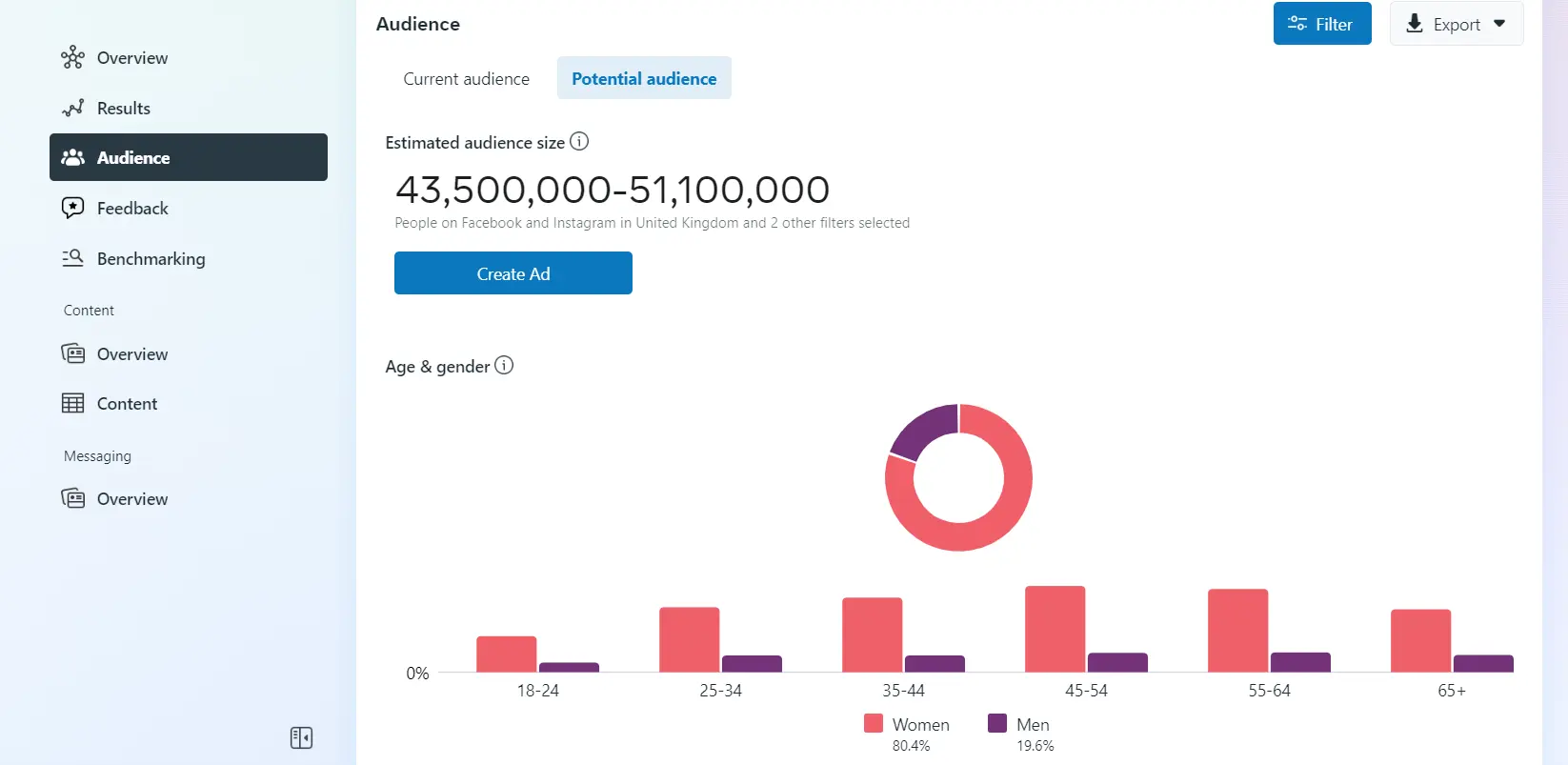
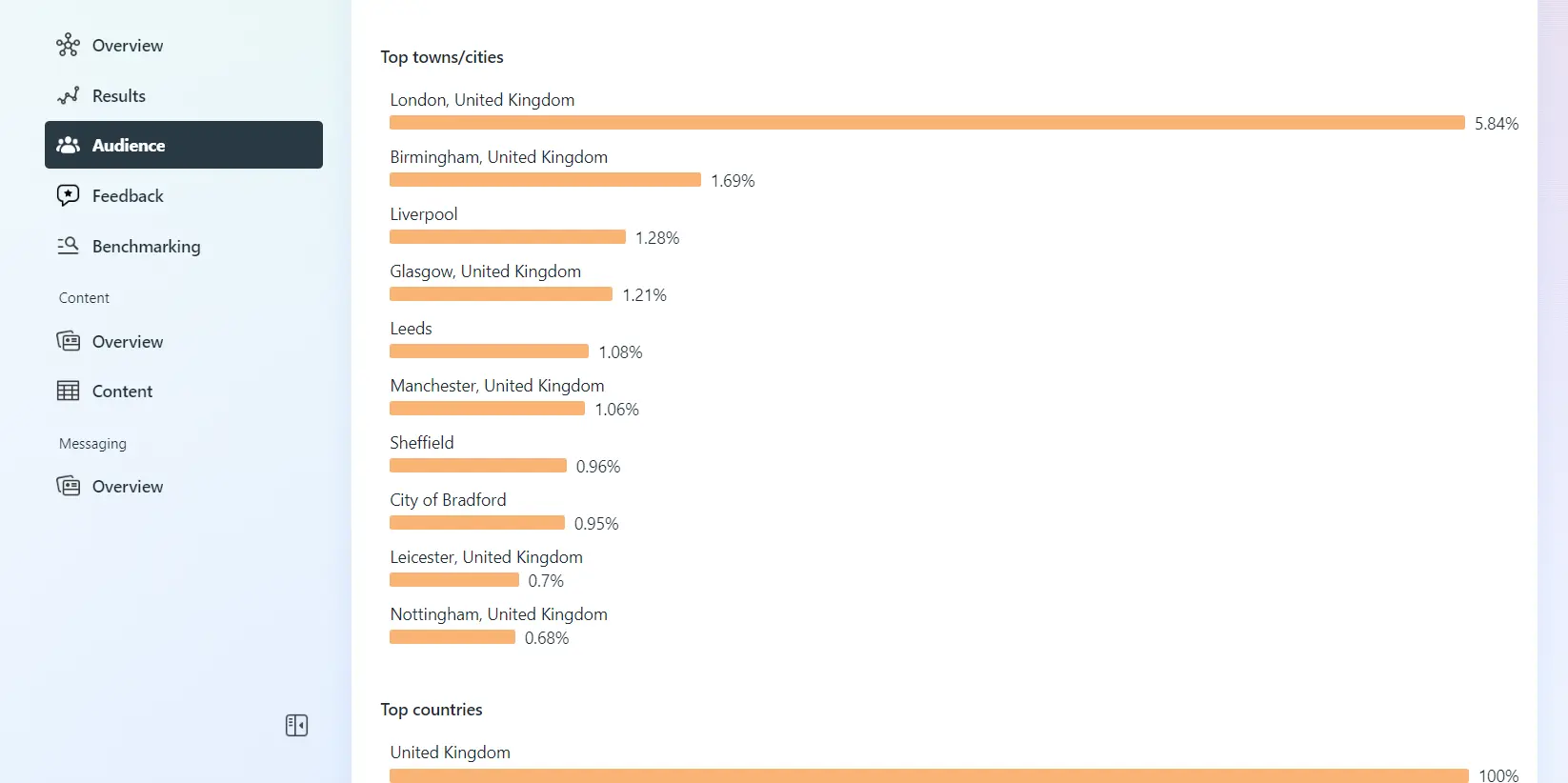
These individuals exhibit a keen interest in your brand. Social analytics can offer a plethora of information that can facilitate an understanding of their motivations. This process can lead to the discovery of potential market segments that you may not have considered targeting previously.
You may also employ social listening to recognise the individuals who are discussing your product and brand on social media, even if they do not follow your accounts.
Survey Your Current Customer Base
Whilst statistics and data are useful tools for analysing customer behaviour, it's always wise to communicate directly with your existing customers.
To gain insight into their preferences, you can inquire about the types of content they consume, which social media platforms they prefer, and the individuals they follow.
To extract first-party data from your customers, you can employ two methods: surveys and interviews. Both offer different advantages. Surveys are convenient, whereas interviews yield hidden gems that are impossible to obtain elsewhere.
Interviews provide a more extensive overview of the customer's experiences. For instance, interviews can identify the emotions associated with a problem and how a specific solution resolves it. Additionally, interviews allow for follow-up questions, which are valuable for obtaining examples and backstory to enhance your notes. You can also use the language used by customers in your marketing messages and keyword research.
Surveys, on the other hand, provide brief responses, single statements, or rambling paragraphs. This lack of detail is insufficient to capture your customer's essence in your content. Nevertheless, surveys are useful for determining who your customers are and which social media platforms they prefer.
To create effective customer surveys, focus on discovering their triggers and habits, which will help you tailor your content to their preferences.
Create or Identify Your Buyer Personas
If your business already has buyer personas, you can leverage the same information to identify your social media target audience. However, if you don't have any personas, you can start by analysing your current customers. What is their age, income, and job type? You can gather demographic details by examining your analytics, social media metrics, and ongoing campaigns.
Once you have these details, you can delve deeper by answering questions like, "What are my audience's pain points?" or "What problems does my product or service solve?" Also, consider factors such as spending power, spending patterns, and their stage of life. All of these elements play a significant role in how customers interact on social media and how they spend their money.
In the end, you may discover more than one persona. For instance, if you have multiple products or services, you may have several buyer personas that you can target.
Analyse Your Competition's Social Media Presence
To better understand your target audience on social media, take a look at your competition. What tone are they using? Who is their audience?
To identify this, check who's engaging with their posts and take note of which social networks they use, their top followers, engagement rate, and hashtags.
You can also search for keywords that you're targeting on social media apps and see what competitors show up.
This information can answer important questions:
- Are your competitors targeting the same market segments as you are?
- Are they reaching segments you hadn't considered before?
- How are they positioning themselves?
While you may not get detailed audience information about the people interacting with your competitors, you can get a general sense of their approach and whether it's effective in creating engagement online.
Refine Your Audience and Find Specific Niches
With the information gathered from your research and surveys, you can now group your target audience into specific categories based on their interests and preferences. While not everyone will fit into the same group, you should be able to identify several clusters of people with similar characteristics.
Facebook Ads Manager is a useful tool to help you narrow down your target audience. You can use it to create highly targeted groups based on a wide range of demographic data. This will also give you an idea of the size of each potential audience segment, helping you avoid targeting too small or too large of a group.
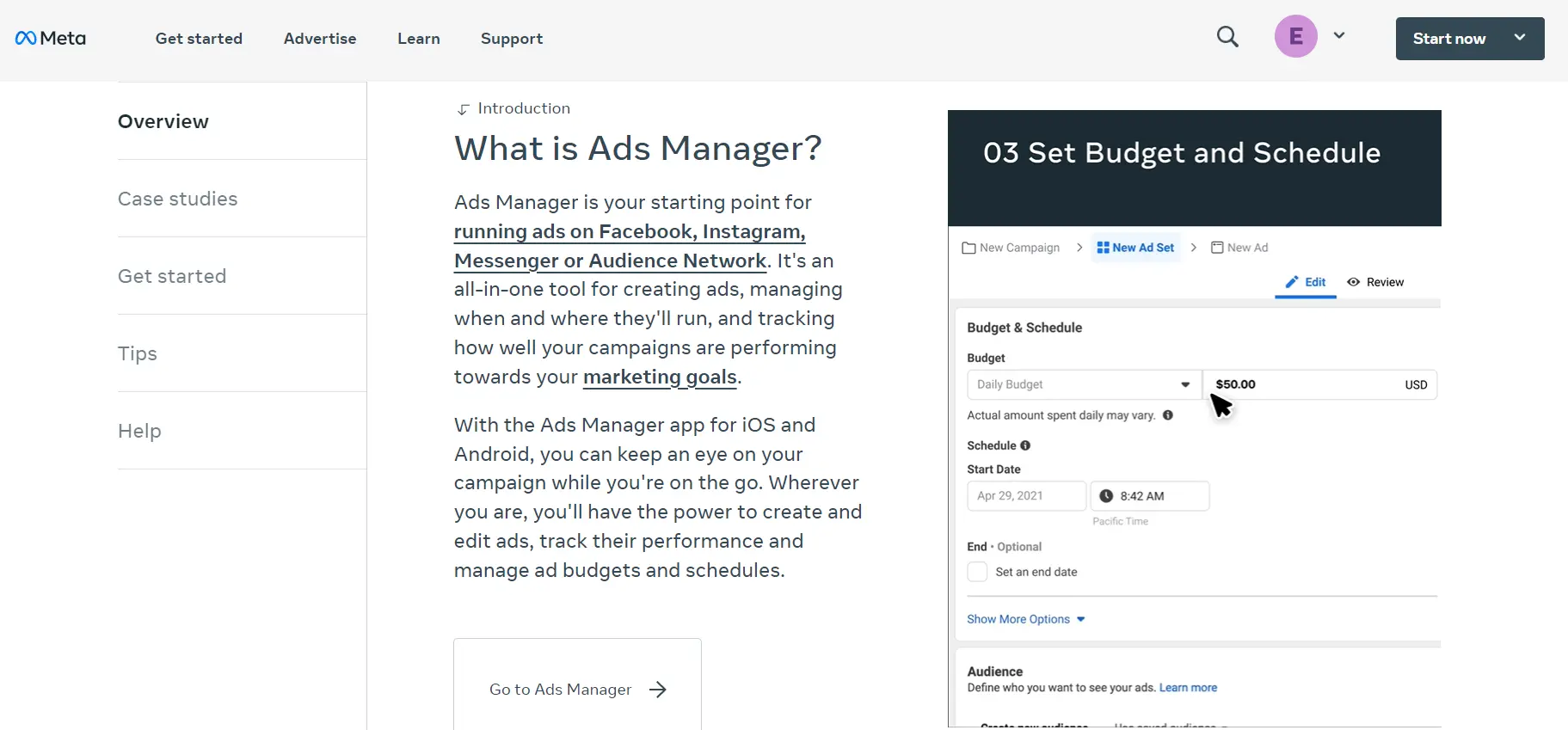
Identifying the key influencers in your niche is also crucial. You can use tools like social media listening to find out who is driving conversations and engagement around your topic. Building relationships with these influencers can help increase your visibility and credibility within your target audience.
Find What And Who Influences Your Audience
Understanding where your target audience goes to seek information and whose opinions they trust is crucial to determine where to share content and identify potential influencers to collaborate with.
One approach to discover this information is to conduct customer surveys or interviews.
However, a platform like Sparktoro can also help to uncover valuable insights about your potential customers through hashtags, keywords, and social accounts.
For instance, Sparktoro's research shows the results of tracking people who follow @EducationWeek
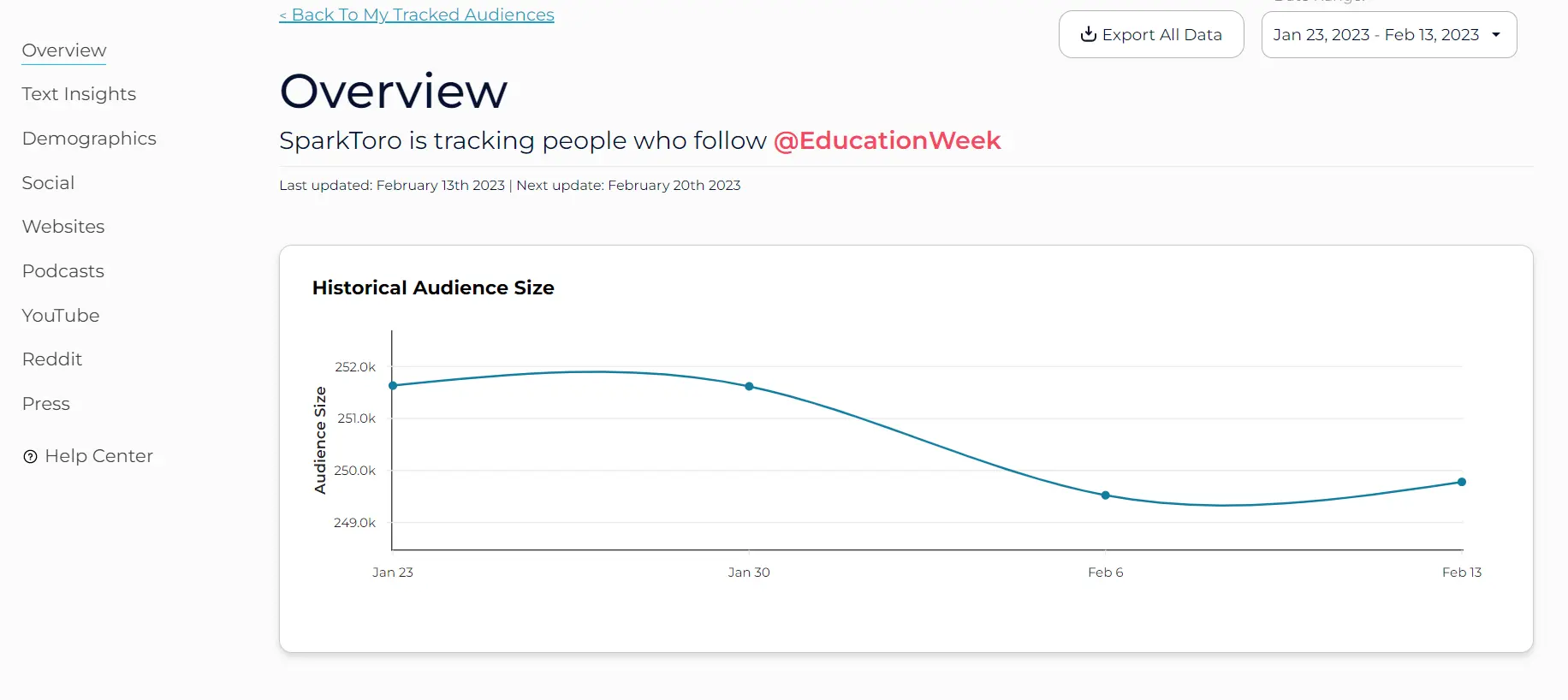
Demographics of the audience:

What the audience follows, visits and engages-with:
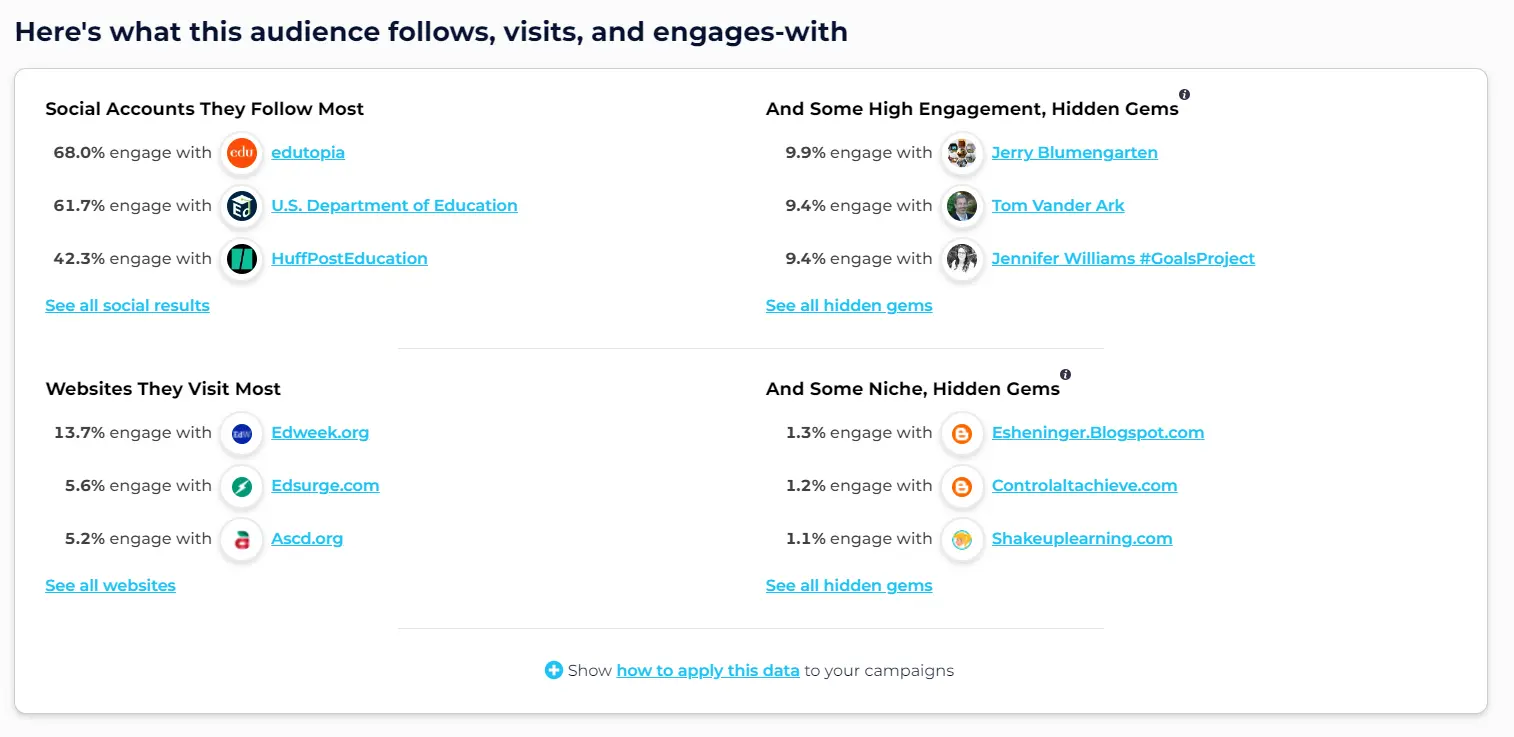
What the audience watches, listens-to and reads:
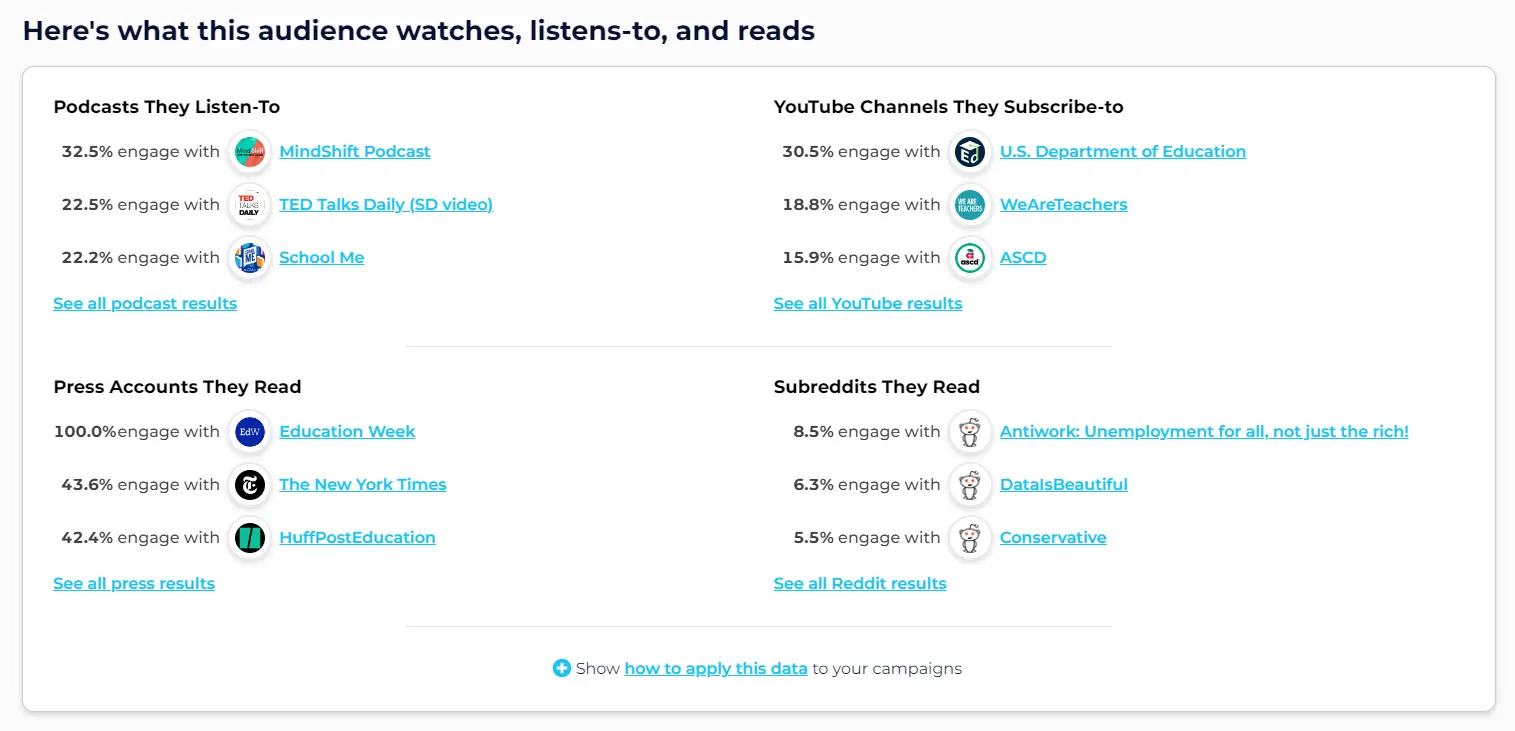
In social media marketing, engagement is more critical than follower count. So, with this knowledge, you can reach out to potential collaborators and promote opportunities to get your content in front of your executive chef audience.
Define Who Your Target Audience Isn’t
It's important to identify the consumers who might be similar to your target audience but are unlikely to respond to your messaging. To achieve this, you should be specific about who your target audience is and who it is not. For instance, is your target demographic men, or men between the ages of 40 and 50? This approach will help you avoid wasting advertising dollars on segments that are not likely to generate returns.
Conduct Plenty of Research
Conducting thorough research is an essential skill for marketers to achieve success. Make use of all available resources to gain a better understanding of your target audience and the most effective marketing messages for them. There are numerous professional studies, research papers, and white papers on social media usage and social media marketing.
One excellent resource for this is the Pew Research Center, particularly its Social Media Fact Sheet. This can provide valuable insights to help you identify and reach your target audience.
If you're tired of struggling to find your target audience on social media, join us at Conte.ai! Our AI autopilot will help you streamline your social media strategy and reach new heights of success. Don't wait - sign up today and start experiencing the power of Conte.ai for yourself!
Connecting With Your Target Audience
To effectively connect with your target audience on social media, it's crucial to have a clear understanding of their preferences and interests. Keeping your audience in mind while creating content and posting on social media can help you establish meaningful connections and drive real growth for your business. Focusing solely on building vanity metrics without considering your target audience can be counterproductive.
Tone of Voice
The tone of voice used in your social media content can greatly impact how your target audience perceives your brand. It's essential to consider what tone will best resonate with your intended audience, whether that be professional, casual, humorous, or another style that aligns with your brand image. Your choice of words, slang, and even the use of emojis should reflect the preferences and interests of your target audience to create a deeper connection with your brand.
For example, take a look at the Instagram account of @benefitcosmetics, which uses the youth slang and includes various emojis in their copy. This approach is likely to appeal to a younger women demographic and those who appreciate a more casual and playful tone. By choosing language and symbols that your target audience relates to, you can create a more engaging and authentic connection with them.

Language
If your target audience is global, it's important to ensure that your language reflects this. Large brands often have multiple social media accounts to best connect with people from different countries, using relevant languages to match. Starbucks is a great example of a brand with tailored accounts for different countries and languages.

Memes
Consider whether your target audience has an appreciation for memes, The Office, pop culture, or other types of cultural phenomena. Are there any popular, niche, or cult fandoms that could align well with your brand? This is worth exploring if it fits with your brand's identity and resonates with your audience.

source: McDonalds

source: G FUEL
When to post
Knowing the best time to post your content on social media is crucial to maximise engagement and reach. Understanding the behavior patterns of your target audience is essential to determine the optimal times to publish your posts. Take into account their daily routines, work schedules, and leisure activities to identify when they are most likely to be active on social media.
For instance, are they likely to scroll through their social media feeds during their lunch break or on their daily commute? Do they spend more time online during the weekends while relaxing on a lazy Sunday? By pinpointing the most opportune times to post, you can increase the chances of your content being seen by your intended audience and ultimately, drive engagement and growth for your brand.
Hashtags
Hashtags remain a relevant tool for search and connectivity in 2023. Consider which hashtags your target audience is searching for, using, and connecting with other people over. What keywords might they use to find products or services similar to your own? Keep in mind that hashtags can also help you build a community. By integrating your content into relevant communities where your target audience already gathers, you can increase your chances of success with this technique.
Targeted adverts
Targeted ads on Facebook, Instagram, and Messenger allow for hyper-specific audience targeting based on the characteristics we previously discussed (and beyond). The level of detail you can achieve with Facebook ads is truly remarkable. If you want to quickly build a following, expand your audience, or promote a product to a larger audience, this may be the perfect strategy for you.
Frequently Asked Questions
What is a target audience?
A target audience refers to a specific group of people who share common interests or characteristics, and are the focus of a business's marketing or advertising campaigns. This includes demographics such as age, industry, hobbies, and location.
How can I find my target audience?
Discovering your target audience requires a combination of customer research, social listening tools, and analysing your competitors to determine where your audience likes to hang out and who they engage with the most.
Why is it important to define your target audience on social media?
Defining your target audience allows you to plan and execute a successful social media marketing strategy. It also enables you to measure the effectiveness of your campaign.
What are the benefits of having a target audience?
Understanding who you want to attract to your business makes it easier to create messaging that resonates with them. Targeting specific groups leads to the creation of more relevant content, which increases engagement and conversion rates.
What is the difference between target market and target audience?
A target market is a broad audience exposed to your message, while a target audience is the specific subset of people who are likely to respond to your messages. For instance, if you sell shoes to a target market of women between 18 and 65, your segmented target audience in your ads may be a younger group between 18 and 30. By focusing on your exact audience, you can tailor your messaging and topics covered in your posts to attract the right people.
Looking to take the stress out of social media management and reach your target audience with ease? Join Conte.ai, the cutting-edge social media AI autopilot that does the hard work for you!
Conclusion
Well said! Defining your target audience on social media is indeed crucial for any business that aims to succeed in the digital world. By understanding who your audience is and what they're interested in, you can create more relevant and engaging content that resonates with them, increasing engagement and conversion rates.
Additionally, it's important to note that social media audience insights can be used in conjunction with other channels, like email, to gain a comprehensive understanding of your audience and develop a well-rounded marketing strategy.
Overall, investing time and resources in defining your target audience can lead to more effective use of your marketing budget, a stronger brand image, and ultimately, increased sales. So, take the time to research and understand your target audience, and tailor your social media marketing efforts accordingly.
